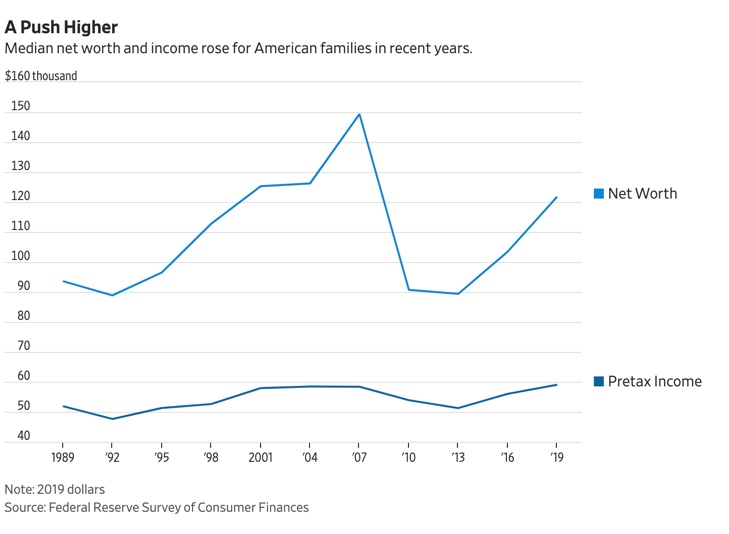Fed Survey shows that low income earners experienced largest growth in household income between 2016 and 2019
Every three years the Federal Reserve publishes a Survey of Consumer Finances. This Survey reports trends on income and wealth. Just recently, the Fed released this year’s survey which covers the period between 2016 and 2019. And according to the survey, families reported positive income gains. before the coronavirus pandemic. As reported by The Wall Street Journal,
U.S. families’ income and wealth rose in the years heading into the coronavirus pandemic, with those in lower-income and lower-wealth categories reaping relatively large gains, the Federal Reserve said in a report on household finances.
As property and stock prices increased, households’ median net worth, or wealth, rose 18% to $121,700 from 2016 to 2019,…..
Median household income—the level at which half are above and half are below—rose 5% to $58,600, before taxes and adjusted for inflation. The rise in incomes came as the economy grew 2.5% a year on average, inflation remained low and the unemployment rate fell.

Low-income individuals hugely benefited
The following graph makes this trend even more impressive.
The distribution of wealth between low- and high-income households narrowed slightly in the latest survey period, Fed economists said, a shift from the 2010-to-2016 period when incomes largely stagnated for all but the most well-off after the 2007-2009 recession.
Families in the lowest two income groups recorded large percentage increases in median net worth, suggesting the decadelong expansion benefited a wide swath of society. Net worth rose 37% to $9,800 for the lowest earners, and increased 40% to $44,000 for the second-lowest group. The median net worth of the highest and second-highest groups declined 8% and 9%, respectively.
A Fed economist said home-ownership gains and rising home prices helped boost household net worth for lower earners.
This is very much in agreement with recent Census Bureau data showing tremendous income gain and a decline in poverty between 2018 and 2019. And as mentioned before, this is a result of a strong economy that has characterized the period under survey. The 2016-2019 period was characterized by a tighter labor market that “drew more low-skilled Americans into the workforce and spurred higher wages”. Other important trends that characterized this period include increased wealth due to a rise in savings among low-income groups, as well as increased homeownership due to rising incomes.
As significant was the growth in business equity, especially among blacks (138%), Hispanics (63%) and Americans without a high-school diploma (104%). The gig economy and online platforms like Etsy have made starting a business easier, but so have the Trump Administration’s deregulation and the 2017 tax reform.
This has strong implications going forward
The coronavirus induced recession has delivered a big blow to the economy. States are facing high unemployment and have to grapple with significantly reduced revenue forecasts. Small businesses are financially fragile and households, especially low-income households, are grappling higher unemployment. It is highly likely that some of these gains will be lost.
But this trend gives an idea of what it would take to bolster the economy. And that would not be higher taxes or increased government. Instead, the high growth period that we see was characterized by, among other things, lower taxes and increased deregulation.
Therefore, it is important that states do not deviate from these principles, and enact policies stifling businesses and individuals in the name of mitigating negative outcomes from Covid-19. We have perfectly seen that it is a growing economy that delivers sustainable income gains to low-income individuals. And a growing economy has never been achieved by a growing government, burdensome regulation or higher taxes, things which seem like might be likely outcomes of the coronavirus recession for most states.